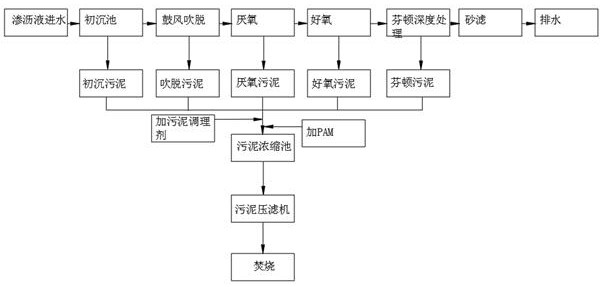Landfill leachate sludge dewatering composite biological enzyme conditioner as well as preparation method and use method thereof
A composite biological enzyme, sludge dewatering technology, applied in water/sludge/sewage treatment, sludge treatment, polluted groundwater/leachate treatment, etc. , the difficulty of deep dewatering of landfill leachate sludge, etc., to achieve the effect of increasing the dryness of the sludge and increasing the filtration speed.
- Summary
- Abstract
- Description
- Claims
- Application Information
AI Technical Summary
Problems solved by technology
Method used
Image
Examples
Embodiment 1
[0040] Weigh the leachate sludge sample to be conditioned at 10m 3 In the plastic bucket, the sludge is taken from before entering the sludge thickening tank, add a certain amount of sludge conditioner, and stir continuously for 90-150 minutes under the condition of 30-50°C, and the stirring speed is 60-80 rpm. Then add a PAM solution with a concentration of 0.1% and continue to stir for 45-60 minutes. After precipitation, use laboratory filter press equipment to squeeze, the pressure is controlled at 0.5MPa, press filter for 5 minutes, and use 5000g of aqueous sludge for each experiment. The experimental results As shown in Table 1 below:
[0041] Table 1: Dryness of leachable sludge after adding sludge conditioner
[0042] serial number formula Conditioning agent ratio (%) PAM ratio (%) Dryness of sludge after press filtration (%) blank 0.5 34 1 A 0.005 0.5 46 2 B 0.005 0.5 47 3 C 0.005 0.5 47 4 A 0.01 0.5 52 ...
Embodiment 2
[0045] The leachate of a waste-to-energy plant supporting a mega city is treated by primary settling, air blowing, anaerobic digestion, aerobic biochemistry, and Fenton, and the sludge before entering the sludge concentration tank is treated at a rate of 0.01%. Add sludge conditioner in proportion, stir continuously for 90-150 minutes at 30-50°C, and stir at a speed of 60-80 rpm, then add PAM solution with a concentration of 0.1% at a ratio of 0.5% and stir continuously for 45-60 minutes , enter the sludge thickening tank after sedimentation, and then filter through the sludge filter press for 5 minutes. The experimental results are shown in Table 2 below:
[0046] Table 2: Dryness of leachable sludge after adding sludge conditioner
[0047] serial number formula Conditioning agent ratio (%) PAM ratio (%) Dryness of sludge after press filtration (%) blank 0.5 37 1 A 0.01 0.5 62 2 B 0.01 0.5 61 3 C 0.01 0.5 59
[0048] T...
Embodiment 3
[0050] The leachate of a waste-to-energy plant in a medium-sized city is subjected to primary settling, blown off, anaerobic digestion, aerobic biochemistry, and Fenton treatment, and the sludge before entering the sludge thickening tank is added at a ratio of 0.01%. Sludge conditioner, stir continuously for 90-150 minutes at 30-50°C, at a stirring speed of 60-80 rpm, then add 0.1% PAM solution in a proportion of 0.5% and continue stirring for 45-60 minutes, and precipitate Then enter the sludge thickening tank, and then filter through the sludge filter press for 5 minutes. The experimental results are shown in Table 3 below:
[0051] Table 3: Dryness of leachable sludge after adding sludge conditioner
[0052] serial number formula Conditioning agent ratio (%) PAM ratio (%) Dryness of sludge after press filtration (%) blank 0.5 38 1 A 0.01 0.5 62 2 B 0.01 0.5 63 3 C 0.01 0.5 62
[0053] The results in the above table s...
PUM
 Login to View More
Login to View More Abstract
Description
Claims
Application Information
 Login to View More
Login to View More - R&D
- Intellectual Property
- Life Sciences
- Materials
- Tech Scout
- Unparalleled Data Quality
- Higher Quality Content
- 60% Fewer Hallucinations
Browse by: Latest US Patents, China's latest patents, Technical Efficacy Thesaurus, Application Domain, Technology Topic, Popular Technical Reports.
© 2025 PatSnap. All rights reserved.Legal|Privacy policy|Modern Slavery Act Transparency Statement|Sitemap|About US| Contact US: help@patsnap.com

